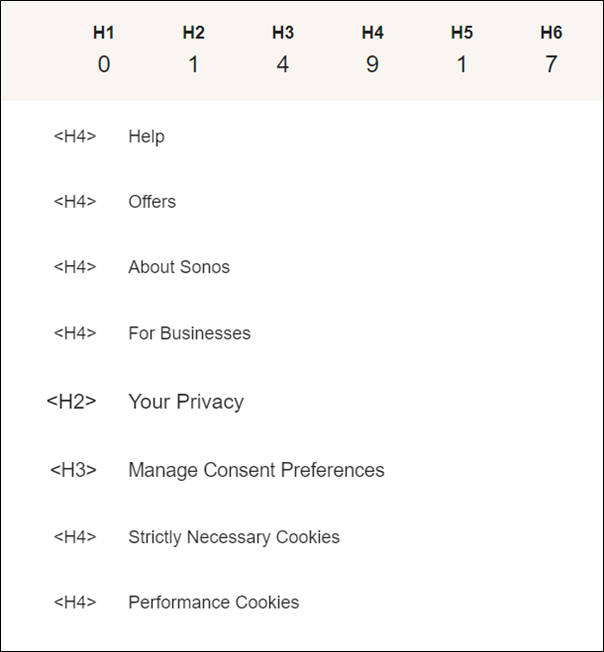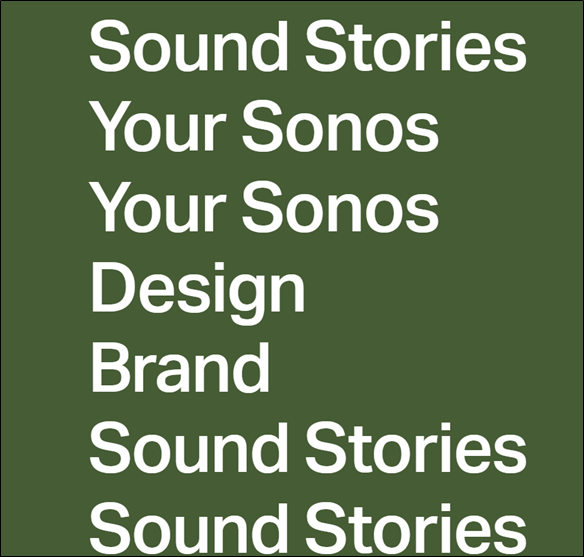In our 2023 consumer electronics report, we took a deep dive into the huge industry behind our favourite gadgets and latest tech. Overall, the market’s visibility fell by 3%, which isn’t huge but does indicate a downwards trend that brands need to be aware of when it comes to their SEO performance.
With every market report, we like to spotlight a brand to investigate and see where their SEO strengths and weaknesses lie, giving some insider knowledge and tips that you can use in your own campaign (and to show-off our expertise).
This month, sonos.com caught our attention – with high authority but low visibility. Coming in at 38 on our visibility leaderboard, they’ve lost 36% year-on-year, despite being a big brand name.
Can we identify some SEO shortcomings and give them some solutions to help them bump up the SERPs?
An authority in the industry
Firstly, we had a look at where Sonos are doing well. They’re a pretty big name brand so this means they have a good number of brand searches (90, 500 monthly!) and, therefore, authority.
But what is authority in the online space? It’s a term we use to describe how respected your site looks to Google and users. As Google pushes E-E-A-T and the importance of relevance, brands need to prove they are experts in their field that consumers should trust.
Sonos.com has a domain rating of 83/100 – you’d definitely want a link from them! They have over 16,000 backlinks including sites like Pinterest (DR: 94), The Guardian (DR: 93), and GQ Magazine (DR: 83). These are a huge green flag to Google, who see the connection as proof of authority and trustworthiness for users.
How to build authority
There are some factors that you can’t influence all that much like site age, but there is a lot you can do:
- Site size
- Domain popularity
- Links from valuable referring domains
- Removing spamming backlinks
- Broad categlogue of helpful content
- Strong internal linking
- Good general technical heath
Patience required: slow pagespeed
While Google can be coy about their ranking factors, they have confirmed that pagespeed is one, which means that faster sites are boosted in search results. For a brand whose business is seamless technology, Sonos have a lot of work to do when it comes to page speed. We use our own pagespeed audit to look at a number of factors that might impact how quickly a site loads, and give it a score so we can create our chart. In 2023, Sonos is 15th – not the worst (that honour goes to hp.com) but their mobile score of 40 is just half of ig.com‘s 81, which takes 1st place.

Recommendations to speed things along
Google considers a load time of less than 3 seconds as the minimum for a good pagespeed, does your site pass the test? If not, there are a few things you can do. Pagespeed is a part of core web vitals, which tell you how healthy your site is from a technical SEO perspective and make a huge impact on user experience.
In Sonos‘ case, they have an issue with Largest Contentful Paint (LCP) – this means the time it takes to load the largest image or block of text on the page. We’re looking for an LCP score of 2.5 or less, but Sonos’ product listing pages and product description pages average over 3.5. To fix this, they’ll need to optimise the assets used on the page, reducing delay time in fetching them and loading them to users.
Pretty technical stuff, right? Plenty of SEO happens in the backend of a site, so keeping things running smoothly behind the scenes is just as important as flashy designs and content.
Off-beat keyword targeting
When we looked into ranking keywords in May 2023 vs May 2022, we see that Sonos has lost 877 keywords – not terrible, especially as they still have over 3000 keywords. However, they have lost some big terms like “alexa” (94,000 sv), “alexa speaker” (4,100 sv), and “smart speakers” (2,500 sv), despite having pages that target these key terms, so what gives?
Their speakers’ page can offer some insights. While the URL is sonos.com/en-gb/shop/wireless-speakers, the meganav anchor text reads just “speakers”, which removes the USP from Google crawlers and users. Once on the PLP, there is a lack of signals targeting the head term. An issue we found across the site is a lack of H1 headings. These are the most important on-page signal as to what the page is about, so this is really fundamental SEO missing.
Take a look: these headings imply the most important information on the page is “privacy”, definitely not sending the right signals.

Improving keyword targeting
The big thing we would recommend is a full review of headings across the site. Identify what the page is about and make sure that is prioritised in the code. Sonos actually have pretty good title tags, so following suit with those will be an easy quick win for a visibility boost. Most the products on the page include “smart speaker” in the product title, therefore, coding product titles as H2s can also be a great way of shouting at Google.
Remember, bots can’t read text as an image, so always make sure that your H1 is rendered separately if you have a banner at the top of the page.
Unplugged supplementary content
One of the best ways to build a strong keyword profile and vie for big-ticket links is to produce supplementary content that supports your industry knowledge. While Sonos does have a well-populated blog with lots of content, it doesn’t seem to be performing very well…

So why is this? Well, firstly, the blog is only accessible from the footer. Although it’s in a large font, it’s still massively hidden away from users and Google crawlers, who are unlikely to go to the bottom of the page. The further down content or links are, the more they are demoted in importance – consider carefully how you order your information for maximum impact.
Even more importantly, the blog is actually on a subdomain: blog.sonos.com
There is absolutely a place for a well-managed subdomain, especially if your business has separate parts that require easy navigation by different audiences. Many big brands use a subdomain for their blog as it keeps the two sides (e-commerce and traffic generation) separate so you can monitor growth more easily.
However, the issue with placing a blog on a subdomain is that the authority is not shared. This means that the impact of any traffic, referring domains, and keywords gained will only support one part. With Sonos, we can see that the strong DR of the main site, including 20, 000 backlinks and 3200 keywords has not helped the blog gain traction.
How to improve content
For Sonos, it may be easier than for others to build a high-flying blog on a subdomain because of brand authority. With the right attention, their blog could easily gain the right backlinks and rank for huge amounts of longtail keywords, bringing in even more traffic and brand awareness. For smaller sites, we would highly recommend to put your content on the same domain to make the most of the full SEO benefits.
Another way we would improve the current blog is to implement a better navigation system. There’s no point in having a great-looking blog with helpful content, if users can’t find what they’re looking for. In their categories, we see a strange selection:

Not only are these repetitive but they’re not very explanatory either. What kind of content is housed under each of these? We don’t know, and neither will Google. When designing a blog, the navigation is one of the most important steps. Make discrete pages for each category and make sure it’s clearly defined – much like a commercial category. Show the depth of your content and keep user experience in mind for the best performance.
Overall…
To sum it up, Sonos.com has really great foundations as a strong brand that people know and actively search out. With big referring links, they have built a high domain authority that is able to carry the site despite lacking SEO fundamentals. From this quick investigation, we can see there are deeper technical health issues that are probably holding them back from success. As these things become more important to Google, they’ll start having big effects on visibility.
Their campaign could do with some tidying up around on-page basics like implementing headings across category pages and PDPs for better navigation and keyword targeting. To make the most of their DR and big name, migrating their blog from a subdomain would help bring the network of information together so they can get the most out of it.
This just scratches the surface of what we look at when assessing a site’s SEO but shows you how much can be found when you pay attention! SEO is ever-evolving and keeping on top of your performance is vital if you want to compete for top spots.
If you’re interested in seeing how your site could be improved or want to get a free professional, in-depth audit on your site, you can contact us online today or call us on 01244 564 500.
